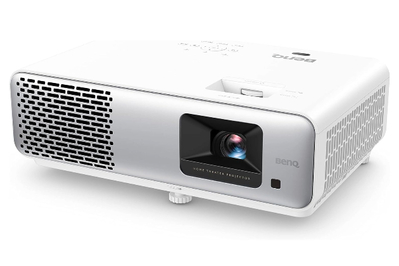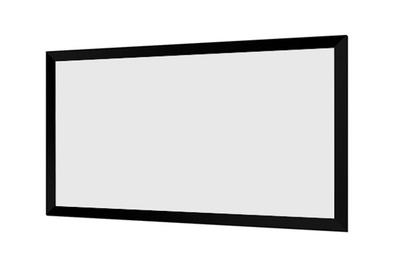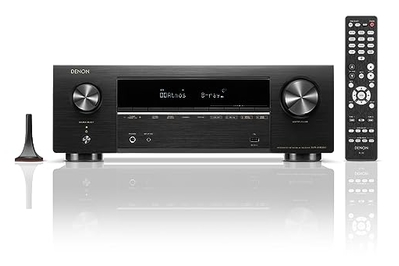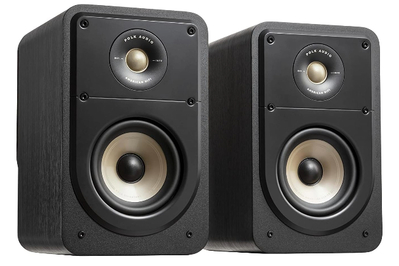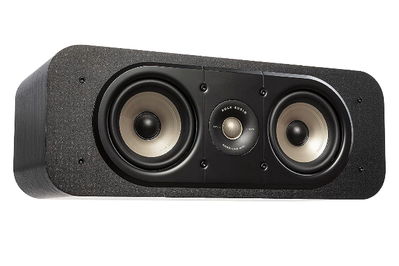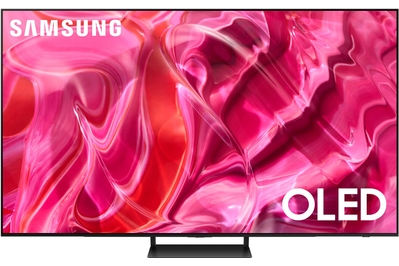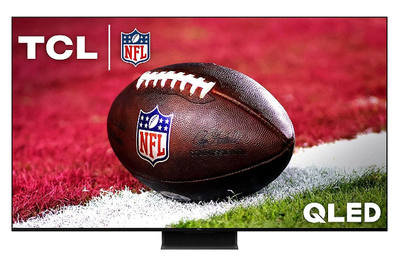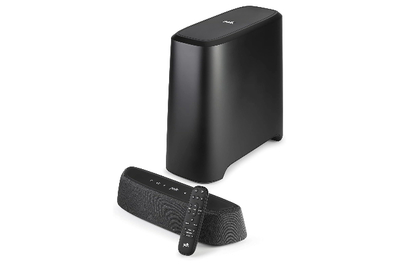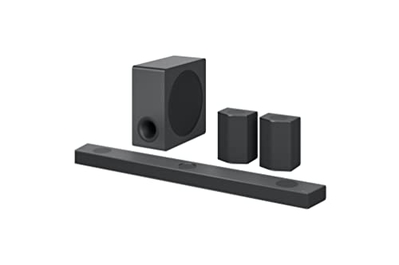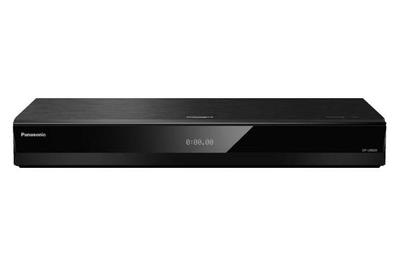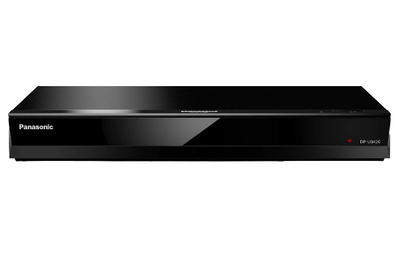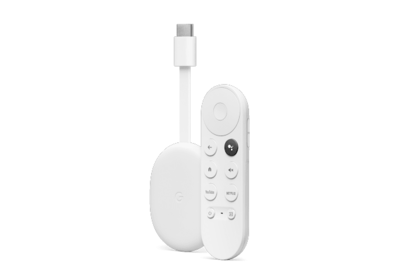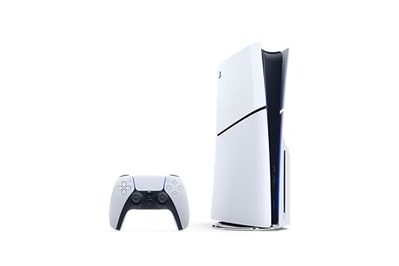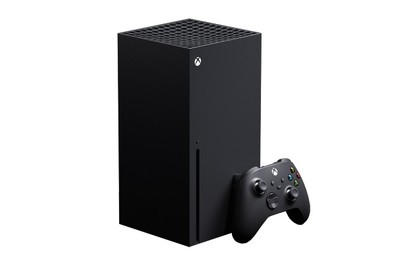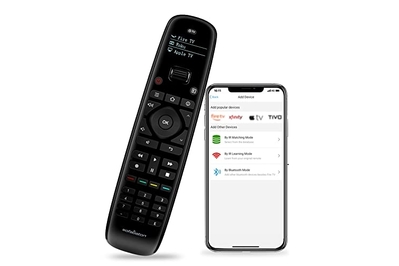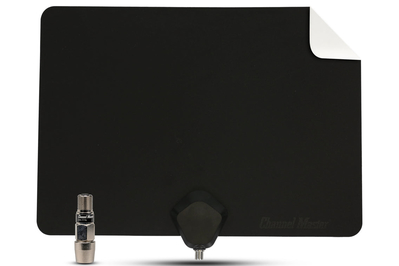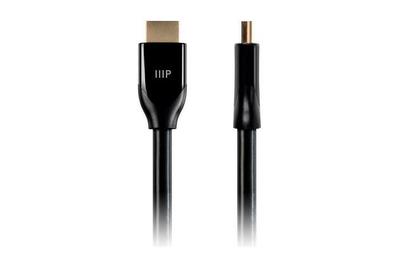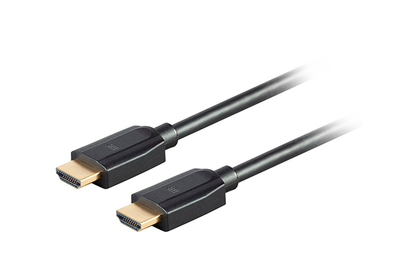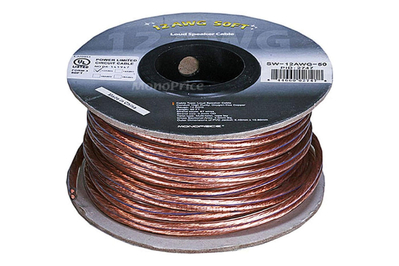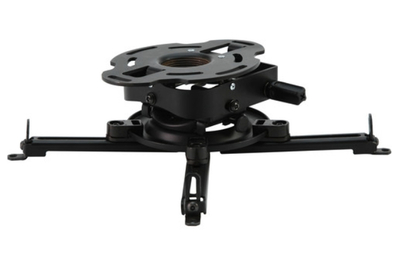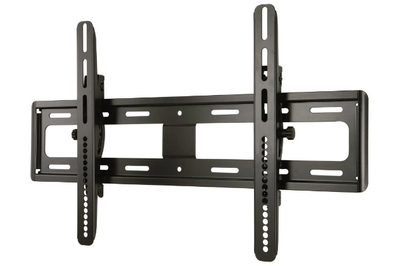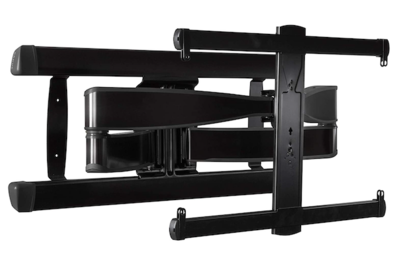
By Grant Clauser and Kathryn Rath
Whether you’re planning to build a dedicated theater room or just thinking of upgrading your living-room system to create a more immersive, theater-like experience, we have video and audio recommendations covering every space and budget.
Our AV team spends thousands of hours each year seeking the best-looking and best-sounding home theater equipment. We discuss almost all of the recommendations below (and more) in our home theater, TV, and projector categories, but we understand that it isn’t always clear how everything fits together. This buying guide compiles everything you need in one place.
Best AV gear for a dedicated home theater
The size of your theater room greatly influences the projector and screen you choose. Most projectors, including our recommendations, come with a chart to help you determine throw distance (the distance required between the screen and the front of the lens), and you should confirm what your room can accommodate before you buy any gear.
A basement rec room measuring about 300 square feet (20 by 15) is large enough to easily fit a 100- to 120-inch screen and a standard, long-throw projector, but you can use an online calculator to figure out what’s right for your room.
Best home theater projectors
Top pick
This laser 4K projector delivers a big, bright, beautiful image and has almost all the features you need—except 3D support.
The Epson Home Cinema LS11000 is our favorite 4K projector because it offers a combination of high-end performance and features that you won’t see in any other 4K projector priced lower than $5,000. It delivers a theater-worthy image with great contrast, detail, and color—yet it’s also bright enough for more casual, everyday TV watching. Plus, its laser light source should last through the next decade or longer, with no need for you to pay for replacement bulbs. It’s easy to set up, too, thanks to its motorized focus, zoom, and lens adjustments.
The LS11000 is also a great 4K gaming projector. It produces low input lag and is one of only a few 120-hertz projectors that have high-bandwidth HDMI 2.1 inputs to work with the most advanced 4K gaming consoles and any future 8K sources that might emerge. The only thing missing is support for 3D video.
Top pick
This projector produces a bright, rich-looking image with more accurate color than most competitors can offer. It’s easy to set up and quiet in operation, but it lacks features like Wi-Fi and Bluetooth support.
We tested a number of projectors around $1,000 or less and found that the BenQ HT2060 had the best picture quality and the easiest setup. Though you have a lot of budget 1080p projectors to choose from, the HT2060 boasts the best combination of black level, brightness, and color accuracy, so it produces a great-looking big-screen movie image. It has a long-lasting LED light source and supports 3D playback and the input of a 4K HDR video signal.
Many budget projectors rely on digital keystoning and zoom to position the image on the screen, which hurts image resolution. The HT2060 offers physical adjustments (1.3x zoom, vertical lens shifting, and adjustable feet) to preserve picture quality. It’s pretty quiet in operation, and its backlit IR remote is easy to use in a darkened room.
Some people may notice the rainbow effect in this DLP projector’s images, and it has no built-in streaming apps. However, a streaming stick connected to one of its HDMI 2.0 inputs solves the latter problem.
Best home theater screen
Top pick
This screen is comparable in performance to those costing seven times as much, plus it’s easy to set up and install. It’s a huge bargain for what it offers.
Buying Options
A good home theater screen should be neutral in color and evenly reflect the appropriate amount of the projector’s light back at you while preserving black level. In our tests, we found that the bargain-priced 100-inch Silver Ticket STR Series screen (in a 16:9 aspect ratio, the shape of an HDTV) was nearly as good as the very expensive Stewart Filmscreen StudioTek 130, a go-to screen for a lot of professional home theater designers.
In comparison with some more expensive screens, the Silver Ticket model’s frame and tautness are not quite as fine, but you probably won’t mind, considering that the $2,000-plus savings you get with the Silver Ticket screen can pay for your projector and more.
Best AV receiver
The AV receiver is the hardest-working component in a home theater. A receiver is both the amplifier and signal processor for your theater. All of the audio and video input signals, and even networking connections, route through the receiver, which processes them and passes them on to your projector and speakers.
Look for a receiver that offers enough inputs for all of your sources—which could include a Blu-ray player, a game console, a media streamer, and more—as well as sufficient power to drive all of your speakers, a good room-calibration system that tailors the system’s performance to your space, and the most up-to-date HDMI connections for your audio and video gear.
Top pick
This is a great-sounding, easy-to-use, 7.1-channel receiver that has all the necessary features to satisfy movie fans, music lovers, and gamers alike.
The Denon AVR-X1800H is a great-sounding receiver that holds your hand through the setup process and is loaded with features. It has seven amplifier channels that can power a surround-sound speaker system or a Dolby Atmos or DTS:X home theater setup with two overhead speakers.
It can also wirelessly stream music via Bluetooth, Apple AirPlay 2, and the Heos wireless streaming platform. Three of its six HDMI inputs are HDMI 2.1 compatible, so it’s great for gaming on more advanced systems such as the Sony PlayStation 5 and the Microsoft Xbox Series X.
The only negatives are that it lacks analog video connections and needs good ventilation because it relies on Class AB amplifier technology, which can heat up the unit with extended use.
Best home theater speakers and subwoofer
Top pick
The ES15 bookshelf speaker pair sounds great, looks cool, and is surprisingly affordable.
Buying Options
The small ES10 is easy to fit or install just about anywhere, so it’s ideal as a surround speaker.
Buying Options
The ES30 is a good, affordable center-channel match for the ES15 and ES10 speakers in a surround-sound system.
The Polk Signature Elite Series is the best deal we’ve found in a surround-sound speaker system. The Signature Elite line includes a variety of options, but we recommend the ES15 for the front left and right channels, the ES10 as surround speakers, and the ES30 center speaker.
We found that these speakers sounded better than many more-expensive systems we tested. In our tests, the combination of the ES15, ES10, and ES30 delivered a robust, full sound with both stereo and surround sources. And the Signature Elite Series’s design is far more stylish than we expect to see in such an affordable speaker line.
Top pick
This 10-inch subwoofer offers an ideal blend of bass power and finesse in a compact package, but you can buy it only directly from the manufacturer.
Buying Options
If you think subwoofers are nothing but big, ugly boom machines, the Rogersound Labs Speedwoofer 10S MKII is likely to be a refreshing surprise. It has practically everything one could want in a midpriced subwoofer, offering the power necessary for action-movie soundtracks and the subtlety and precision required for great sound on music recordings.
It incorporates a 10-inch woofer in a ported enclosure, driven by a 400-watt internal amplifier, and it has the necessary connections for you to add it to most any audio setup. Plus, it measures a relatively compact 16 by 15 by 16.75 inches (HWD). But it is sold only through the Rogersound Labs website.
Best AV gear for a living-room theater
Don’t have a basement or a spare room to dedicate to your personal cinema? You can still put together a great home theater system—but you may have to make a few compromises.
The main challenge in a living room is accommodating the room’s space, shape, and light. Living rooms aren’t always nice rectangles suitable for a theater orientation, and they often open up to dining rooms, foyers, and kitchens. They may be L-shaped or have stairs, doors, and windows in all the wrong places. Seating may include a sofa and mismatched chairs scattered around the room. They’re also not caves, so light from windows, lamps, or nearby rooms is likely to be leaking (or pouring) in.
Best TVs for a living-room home theater
We don’t recommend that most people use a projector as their main display in a living room. The location usually has too much ambient light (fixable, but the options are expensive), and a ceiling-hung projector paired with a fixed screen isn’t the look that most families want for their main meet-and-greet space. Ultra-short-throw projection systems are often marketed as TV replacements, but we don’t think they’re the right fit for most people.
Flat-screen TVs, especially large models, are the ideal display for a living-room theater. Because a TV is brighter than a projector-and-screen setup, you can watch with the lights on or the blinds open. And today’s ultra-large flat panels are generally light enough to fit in most TV wall mounts, so you can keep them secure and save space.
Top pick
This TV delivers stunning picture quality and great features for a relatively reasonable price. But it does not support Dolby Vision HDR.
For the absolute best home theater experience in a living room, we recommend the Samsung S90C Series, our top pick for the best OLED TV. Combining an OLED panel with quantum-dot color technology, the S90C delivers stunning 4K HDR imagery for both movies and gaming, and it’s available in sizes from 55 to 83 inches. The Smart Hub smart-TV platform is easy to use, highly responsive, and compatible with all major video and audio streaming services. Plus, OLED TVs have wide viewing angles, so the picture looks great no matter where you’re sitting.
The drawbacks: Samsung TVs don’t support the Dolby Vision HDR format, and OLED TVs carry higher price tags than LCD TVs do, especially at larger screen sizes.
Top pick
Capable of dazzling brightness and vibrant colors, this TV is a standout performer amongst LCD/LED TVs, but it’s available only in larger screen sizes.
If you’re looking for great performance at a lower price, the TCL QM8 Series is the way to go. Thanks to its mini-LED backlighting and quantum-dot color technology, this 4K LED/LCD TV offers excellent brightness, contrast, and color vibrancy. Despite being one of the brightest TVs we’ve tested, the QM8 still delivers dark black levels with great shadow detail, though it can’t rival OLED in that respect. It also has a 120 Hz refresh rate to produce cleaner, smoother motion.
Like other LCD TVs, the QM8 loses image saturation if you aren’t sitting front and center, but it’s better than many competitors in this regard. It also doesn’t come in a 55-inch or smaller screen size.
Best soundbars
If you don’t like the idea of speakers and wires strewn about your living room, our soundbar picks are a good alternative to a surround-sound speaker system. There are plenty of basic, affordable models that will sound better than the speakers in your TV, but our recommendations will provide a higher-quality, more theaterlike audio experience.
Top pick
Despite being simple, small, and affordable, this soundbar outperforms many larger, more complicated competitors.
The Polk MagniFi Mini AX proves that you can’t judge a book by its cover. The top pick for the best soundbar packs a lot of punch in a discreet design. Tested against larger soundbars with more features and higher price tags, the MagniFi Mini AX came out on top with our listening panel. Its five-speaker array and SDA technology produce surprisingly spacious sound for movies and TV shows, and it can stream audio over Wi-Fi, Bluetooth, and Apple AirPlay 2.
Thanks to its 14.5-inch width, it can fit almost anywhere, and it offers an HDMI eARC connection, as well as optical digital-audio and analog-audio inputs. The soundbar also supports Alexa voice control. Optional surround speakers are available for purchase separately.
Upgrade pick
The S95QR includes a powerful subwoofer, surround speakers, five upward-firing Atmos speakers, and lots of inputs and audio streaming options.
If you want a more immersive soundbar, the LG S95QR gets you pretty close to the sonic experience of having an AV receiver and surround-sound speaker system, but with easier setup. Billed as a 9.1.5-channel system, the S95QR has three upward-firing immersive speakers built into the top of the soundbar, plus one more upward-firing speaker built into each of the wireless surround speakers.
This system’s extra upward-firing speaker and IMAX Enhanced feature produces a highly enveloping sound, especially with movies encoded in the Dolby Atmos and DTS:X formats—and it also plays very loud without strain. The subwoofer produces powerful, punchy deep bass that really energizes a room (and your emotions).
Best home theater sources
Here you’ll find the sources necessary to complete any home theater setup.
Best Blu-ray players
Top pick
This player supports all the major HDR formats, including Dolby Vision, and provides the best image quality with 4K Ultra HD discs, thanks to custom tone mapping that optimizes HDR video for your display.
If you want the highest quality from your Ultra HD Blu-ray discs, the Panasonic DP-UB820 is the way to go. While 4K content looked essentially identical through other players we tested, this model’s optional HDR Optimizer feature improved the image on most HDR displays. It also offers superior upscaling of Blu-ray and DVD discs, so it can make your entire disc collection look better.
The DP-UB820 supports the HDR10, HDR10+, HLG, and Dolby Vision HDR formats. In addition, this model provides more audio-connection options, has a front-panel display, and is faster in use than the DP-UB420, but it costs more.
Budget pick
This player delivers most of the benefits of the pricier DP-UB820, but it lacks support for the Dolby Vision HDR format.
The Panasonic DP-UB420 is the best dedicated UHD Blu-ray player we have tested under $300. It offers nearly the same features as the DP-UB820, like an HDR Optimizer, for several hundred dollars less and supports many of the same formats. All it’s lacking is Dolby Vision support and the 7.1-channel analog audio outputs.
Best streaming media player
Top pick
The Chromecast player offers an intuitive interface, intelligent search, a useful remote, and support for 4K HDR video, including Dolby Vision.
Even though Blu-ray discs provide a better picture and better audio quality than streaming services, we know that most people depend on streaming services for most of their movie watching. While most Blu-ray players, TVs, and other video sources have a few streaming services built in, a dedicated media streamer offers the most robust way to get your online media.
After researching and testing every major streaming media player, we’ve determined that the Google Chromecast with Google TV is the one you should buy. The menu system does the best job of finding and organizing content in comparison with other media streaming devices. Instead of presenting a home screen with a bunch of separate streaming services (such as Netflix, Hulu, and Amazon Prime Video), Google TV groups all your recently watched shows and movies together along with your watchlist of preferred content—making it easier and faster for you to find what you want to watch.
The player has a compact size and comes with a useful remote that supports voice search through Google Assistant.
Best game consoles
Top pick
This game console has a disc drive so you can watch UHD Blu-ray movies, as well as play new or used PS5 and PS4 game discs.
Get the Series X if you want Dolby Vision support and the absolute best in graphics like raytraced lighting effects, plus a disc drive for games and movies.
The latest, top-shelf PlayStation and Xbox game consoles are great for a home theater because, in addition to offering excellent gameplay, they support 4K HDR video playback, and they have disc drives through which you can play UHD Blu-ray discs. The PS5 does not support Dolby Vision or DTS:X, though—so if you want to take advantage of either standard, the Xbox may be the better choice.
Read more in our guide to the best game consoles.
Best home theater accessories
Best universal remote
Top pick
This remote can control 15 AV components, including Bluetooth-based devices, and the button layout is intuitive. But it lacks backlighting and activity buttons, and programming advanced tasks can be challenging.
Buying Options
The remotes that come with your AV devices do a good to fair job of operating the device they were each designed to operate—but if you’ve ever done the remote shuffle just to watch a movie, you can understand the appeal of having one remote to control everything in your home theater.
There’s very little competition in the do-it-yourself universal remote control market these days, especially after Logitech’s discontinuation of its popular Harmony remote line. If you have a complex home theater system and you want to integrate control of lighting and other smart-home equipment, your best bet is to turn to a local specialty AV retailer that can create a more-personalized control system from a company like Crestron or Control4. It’s a more expensive option, but if done properly, it will result in a much more satisfying experience.
If you just need to control your AV gear and want a do-it-yourself setup, the Sofabaton U2 Universal Remote Control is a well-designed universal remote that offers a lot more features than you might expect for around $50. It can control up to 15 devices, including both infrared- and Bluetooth-based AV devices, but it also has some notable downsides. Check out our guide to the best universal remote to read more.
Best TV antennas
Top pick
Of all the antennas we tested, this passive, non-amplified antenna gave us the best results on average, and it’s affordable and easy to install. The detachable cable is stiff, however.
Buying Options
The amplified version of the FLATenna may work better if you live more than 20 miles from TV transmitters. But at closer distances, the amp can reduce performance.
Buying Options
May be out of stock
If you’ve cut the cord but still want the live-TV experience—be it for sports, news, special events, or local foreign-language broadcasts—an inexpensive TV antenna could be the best way to go. We recommend starting with the Channel Master FLATenna because, no matter where we hung this antenna, it was always one of the best in pulling in the most TV channels. The antenna has a 12-foot, detachable cable; its flat design makes it easy to hang on a wall, and it’s reversible, with black and white sides. This antenna is passive, so it doesn’t need to connect to an AC outlet—all you have to do is plug it into your TV.
However, if you live in a remote area where pulling over-the-air (OTA) TV channels is difficult, the amplified Channel Master FLATenna+ may be a better option. Its built-in amplifier can improve long-range reception. That said, in our tests, using the amplifier at a shorter range substantially reduced the number of channels we received. The amplifier is also available separately, so you can buy the passive version and add the amp later if you move, but buying it separately is more expensive.
Best HDMI cables
You’ll need a few HDMI cables for your home theater—just don’t pay too much for them. HDMI cables send data digitally, so despite what some manufacturers claim, you’ll get no video- or audio-quality improvement from a high-end HDMI cable. Basically, all you need is for the picture and sound to make it reliably from the source to the display.
Some older HDMI cables lack the bandwidth to send 4K HDR, so you want to look for high-speed or ultra-high-speed cables. We’ve tested our recommendations below to ensure that they work with the latest AV formats.
Top pick
This inexpensive but well-built HDMI cable is available in many lengths, and in our tests it handled 4K HDR video with no issues.
Upgrade pick
Most people don’t need Ultra High Speed HDMI cables, but if you own the latest gaming consoles or you plan to buy an 8K TV, we recommend this Monoprice 8K cable.
The Monoprice 4K Certified Premium High Speed HDMI Cable is a great choice for most people because it can transmit any current video standard up to 4K video at 60 Hz, it has Ethernet data and Audio Return Channel capabilities, and it comes with a lifetime warranty.
If you’re a gamer who needs to pass higher-bandwidth 4K 120 Hz signals, consider the Monoprice 8K Ultra High Speed HDMI Cable instead. This cable is capable of transmitting higher resolutions and frame rates at a bandwidth up to 48 Gbps. You don’t need that much bandwidth just to pass 4K HDR movies and TV shows between a TV and source device. But the Sony PlayStation 5, the Microsoft Xbox Series X, and high-end gaming PCs are capable of outputting 4K video at 120 frames per second (or 4K 120 Hz), which requires more bandwidth. If you have one of these devices—as well as one of the few TVs that can accept this higher-bandwidth signal—you need an Ultra High Speed HDMI cable.
Likewise, if you’ve purchased (or plan to purchase) an 8K TV and want to make sure your cables are ready for future 8K sources, you might want to go ahead and upgrade your cables.
Best speaker cable
Top pick
This well-made, affordable speaker wire, in a gauge that's suited to a wide range of speaker binding posts, will satisfy casual and critical listeners alike.
Buying Options
Our past research and testing showed that there really is no best speaker cable. The Monoprice 2747 12 gauge is the speaker wire we’d buy because it offers excellent value and sturdy construction. In our testing, it sounded fuller and richer than many competitors, especially those with thinner gauges.
While other speaker wire may sound slightly better with certain audio systems, that’s a needle-in-a-haystack search that’s simply not worth it for most people. A speaker cable’s impact is negligible, so save your time and money by going with the Monoprice 2747.
Best projector mount
Top pick
Among those we’ve used, this model comes the closest to being the perfect projector mount.
The Peerless-AV PRGS-UNV universal projector mount is one of our favorites due to how flexible it is and how easy it is to set up correctly. The mounting arms are highly adjustable and removable, so it can accommodate anything from a tiny DLP projector to a gigantic 4K laser projector. The dials let you make small adjustments to the projector to get it level with the screen and produce the best image without much work.
Best TV wall mounts
Top pick
A sturdy build and helpful post-installation adjustments make this model our favorite tilting TV wall mount.
After all of our research and testing, we concluded that the best tilting TV mount is the Sanus VMPL50A-B1. This UL-approved mount is designed for TVs ranging in size from 32 to 85 inches and can hold up to 150 pounds. It is compatible with 22 VESA patterns, and ours came with 10 bolt sizes, the largest selection of any mount we tested.
This Sanus model has one of the thinnest profiles of the mounts we tested, holding the back of the TV about 1.8 inches off the wall—yet when tilted, it still gives you room to get a hand behind the TV for wiring purposes. In our tests, installation was quick and easy, and after the TV is in place, the mount remains fully adjustable, both side to side (in case your studs aren’t in exactly the right place) and for level correction.
Upgrade pick
This model offers a long extension, easy adjustments, and smooth motion. Its long mounting bars provide a lot of flexibility for you to center the TV on a wall.
If you prefer a full-motion mount that lets you point the TV at different parts of the room, the UL-approved Sanus VLF728-B2 (also sold as the Sanus BLF328-B1) works with TVs ranging from 42 to 90 inches. It can extend a TV up to 28 inches off the wall—farther than most—which also gives it a wide range of side-to-side pivot. To stabilize the weight of the TV, the arms are large, but when you press the mount back against the wall, it has a thin profile of just over 2 inches.
The mount’s smooth extension and pivoting motion give it a high-quality feel, and the adjustments, from the tilt lock to the screen leveling, are easy to use. This Sanus mount is large, but its 32-inch-wide mounting bars allow for greater flexibility with placement. It is compatible with 16 VESA patterns.
This article was edited by Adrienne Maxwell and Grant Clauser.
Meet your guides

Grant Clauser
Senior Editor
I’m an editor whose coverage areas encompass audio, video, and smart-home devices, including headphones, TVs, and security cameras.

Kathryn Rath
I’m a writer based in New York whose coverage areas include audio and video gear such as headphones, speakers, TVs, and projectors. I also cover smart devices for the home.
Mentioned above
- The Epson LS11000 4K laser projector delivers a big, beautiful image, works well in a variety of lighting conditions, and has most of the features you need.The Best 4K Projector
- The BenQ HT2060’s good contrast, bright output, and impressive color accuracy make it our pick for the best budget home theater projector.The Best Budget Projector for a Home Theater
- A good projector screen is an essential complement to a home projector. We have recommendations for value-oriented fixed-frame, pull-down, and DIY screens.The Best Projector Screen on a Budget
- The Denon AVR-X1800H is an easy-to-use AV receiver that sounds great and has the necessary features to meet most people’s movie, music, and video-gaming needs.The Best AV Receivers for Most People
- If you want the best AV presentation of your favorite films, we recommend 4K Ultra HD Blu-ray discs, and the Panasonic DP-UB820 is the best player we’ve tested.The Best 4K Blu-ray Player
- Video game consoles are more popular than ever, but it can be hard to figure out the right one to buy. We’re here to help—assuming you can find one.The Best Game Consoles
Further reading
How to DIY Your Own Outdoor Movie Theater
by Geoffrey Morrison and Adrienne Maxwell
Skip the cinema this summer and enjoy a movie night in your backyard.
The Best Projectors
by Adrienne Maxwell
We reviewed every type of projector to find the best projector to fit your needs, whether it’s for a home theater or a home office.
The Best Gear for Small Apartments
by Wirecutter Staff
We consulted four small-space experts to help you decide what to buy (and not buy) to optimize your small apartment.
How to Build the Best Multiroom Wireless Speaker System for You
by Dennis Burger
There are myriad ways to build a multiroom audio system. We help you find the path that’s best for you.



